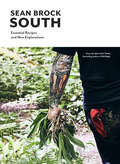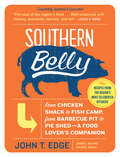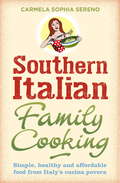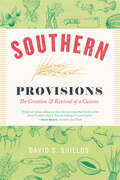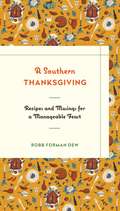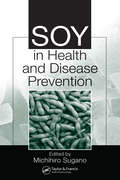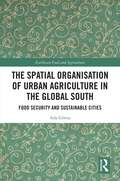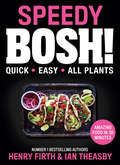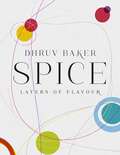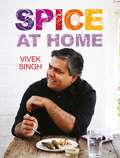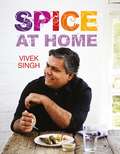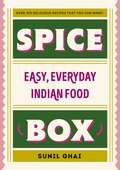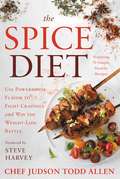- Table View
- List View
South: Essential Recipes and New Explorations
by Sean BrockIn the follow-up to the award-winning and bestselling Heritage, Sean Brock writes the bible on Southern cooking and teaches all the elements of this beloved cuisine.
South Africa (Routledge Library Editions: South Africa #4)
by Monica ColeOriginally published in 1961, this book was the first comprehensive work on South African geography that also presented a balanced account of all facets of the economic life. It was written to provide background information on South Africa – the nature of the country, its resources and deficiencies, its historic settlement by peoples of different races and of the progress made and the difficulties encountered in the major areas of economic activity: agriculture, mining, manufacturing and trade. In discussing these factors the book acknowledged that in South Africa the complexities of the relationships between peoples of different racial origins and widely differently economic and cultural standards are met in one country.
South Africa (Routledge Library Editions: South Africa #4)
by Monica ColeOriginally published in 1961, this book was the first comprehensive work on South African geography that also presented a balanced account of all facets of the economic life. It was written to provide background information on South Africa – the nature of the country, its resources and deficiencies, its historic settlement by peoples of different races and of the progress made and the difficulties encountered in the major areas of economic activity: agriculture, mining, manufacturing and trade. In discussing these factors the book acknowledged that in South Africa the complexities of the relationships between peoples of different racial origins and widely differently economic and cultural standards are met in one country.
Southern Belly: A Food Lover's Companion
by John T. EdgeJohn T. Edge, "the Faulkner of Southern food" (the Miami Herald), reveals a South hidden in plain sight, where restaurants boast family pedigrees and serve supremely local specialties found nowhere else. From backdoor home kitchens to cinder-block cafés, he introduces you to cooks who have been standing tall by the stove since Eisenhower was in office. While revealing the stories behind their food, he shines a bright light on places that have become Southern institutions. In this fully updated and expanded edition, with recipes throughout, Edge travels from chicken shack to fish camp, from barbecue stand to pie shed. Pop this handy paperback in the glove box to take along on your next road trip. And even if you never get in the car, you'll enjoy the most savory history that the South has to offer.
Southern Italian Family Cooking: Simple, healthy and affordable food from Italy’s cucina povera
by Carmela Sophia SerenoHealthy food on a sensible budget is important to many of us today but in Southern Italy, la cucina povera has been a philosophy for generations. These are delicious, filling recipes that will become family favourites in your own home, such as:· Antipasti – traditional starters, cured meats with bread and vegetables in oil.· Slow cooked meals such as ragu – a delicious tomato based sauce with meat.· Stuffed peppers, using stale bread and herbs to fill peppers prior to baking.· Mussels in a tomato and white wine sauce. · Pork cotolette, pork escalopes covered in egg and seasoned breadcrumbs, flash fried.· And a range of fabulous desserts for when we want a sweet treat – smooth panna cotta with berries and tasty tiramisu.It’s not just about the food; it’s about the whole ethos of Italian family life. This books shows you how to be creative with what’s available to you and gives you an incredibly healthy way to live and enjoy food with family and friends.
Southern Provisions: The Creation and Revival of a Cuisine
by David S. ShieldsSouthern food is America’s quintessential cuisine. From creamy grits to simmering pots of beans and greens, we think we know how these classic foods should taste. Yet the southern food we eat today tastes almost nothing like the dishes our ancestors enjoyed, because the varied crops and livestock that originally defined this cuisine have largely disappeared. Now a growing movement of chefs and farmers is seeking to change that by recovering the rich flavor and diversity of southern food. At the center of that movement is historian David S. Shields, who has spent over a decade researching early American agricultural and cooking practices. In Southern Provisions, he reveals how the true ingredients of southern cooking have been all but forgotten and how the lessons of its current restoration and recultivation can be applied to other regional foodways. Shields’s turf is the southern Lowcountry, from the peanut patches of Wilmington, North Carolina to the sugarcane fields of the Georgia Sea Islands and the citrus groves of Amelia Island, Florida. He takes us on a historical excursion to this region, drawing connections among plants, farms, growers, seed brokers, vendors, cooks, and consumers over time. Shields begins by looking at how professional chefs during the nineteenth century set standards of taste that elevated southern cooking to the level of cuisine. He then turns to the role of food markets in creating demand for ingredients and enabling conversation between producers and preparers. Next, his focus shifts to the field, showing how the key ingredients—rice, sugarcane, sorghum, benne, cottonseed, peanuts, and citrus—emerged and went on to play a significant role in commerce and consumption. Shields concludes with a look at the challenges of reclaiming both farming and cooking traditions. From Carolina Gold rice to white flint corn, the ingredients of authentic southern cooking are returning to fields and dinner plates, and with Shields as our guide, we can satisfy our hunger both for the most flavorful regional dishes and their history.
Southern Provisions: The Creation and Revival of a Cuisine
by David S. ShieldsSouthern food is America’s quintessential cuisine. From creamy grits to simmering pots of beans and greens, we think we know how these classic foods should taste. Yet the southern food we eat today tastes almost nothing like the dishes our ancestors enjoyed, because the varied crops and livestock that originally defined this cuisine have largely disappeared. Now a growing movement of chefs and farmers is seeking to change that by recovering the rich flavor and diversity of southern food. At the center of that movement is historian David S. Shields, who has spent over a decade researching early American agricultural and cooking practices. In Southern Provisions, he reveals how the true ingredients of southern cooking have been all but forgotten and how the lessons of its current restoration and recultivation can be applied to other regional foodways. Shields’s turf is the southern Lowcountry, from the peanut patches of Wilmington, North Carolina to the sugarcane fields of the Georgia Sea Islands and the citrus groves of Amelia Island, Florida. He takes us on a historical excursion to this region, drawing connections among plants, farms, growers, seed brokers, vendors, cooks, and consumers over time. Shields begins by looking at how professional chefs during the nineteenth century set standards of taste that elevated southern cooking to the level of cuisine. He then turns to the role of food markets in creating demand for ingredients and enabling conversation between producers and preparers. Next, his focus shifts to the field, showing how the key ingredients—rice, sugarcane, sorghum, benne, cottonseed, peanuts, and citrus—emerged and went on to play a significant role in commerce and consumption. Shields concludes with a look at the challenges of reclaiming both farming and cooking traditions. From Carolina Gold rice to white flint corn, the ingredients of authentic southern cooking are returning to fields and dinner plates, and with Shields as our guide, we can satisfy our hunger both for the most flavorful regional dishes and their history.
Southern Provisions: The Creation and Revival of a Cuisine
by David S. ShieldsSouthern food is America’s quintessential cuisine. From creamy grits to simmering pots of beans and greens, we think we know how these classic foods should taste. Yet the southern food we eat today tastes almost nothing like the dishes our ancestors enjoyed, because the varied crops and livestock that originally defined this cuisine have largely disappeared. Now a growing movement of chefs and farmers is seeking to change that by recovering the rich flavor and diversity of southern food. At the center of that movement is historian David S. Shields, who has spent over a decade researching early American agricultural and cooking practices. In Southern Provisions, he reveals how the true ingredients of southern cooking have been all but forgotten and how the lessons of its current restoration and recultivation can be applied to other regional foodways. Shields’s turf is the southern Lowcountry, from the peanut patches of Wilmington, North Carolina to the sugarcane fields of the Georgia Sea Islands and the citrus groves of Amelia Island, Florida. He takes us on a historical excursion to this region, drawing connections among plants, farms, growers, seed brokers, vendors, cooks, and consumers over time. Shields begins by looking at how professional chefs during the nineteenth century set standards of taste that elevated southern cooking to the level of cuisine. He then turns to the role of food markets in creating demand for ingredients and enabling conversation between producers and preparers. Next, his focus shifts to the field, showing how the key ingredients—rice, sugarcane, sorghum, benne, cottonseed, peanuts, and citrus—emerged and went on to play a significant role in commerce and consumption. Shields concludes with a look at the challenges of reclaiming both farming and cooking traditions. From Carolina Gold rice to white flint corn, the ingredients of authentic southern cooking are returning to fields and dinner plates, and with Shields as our guide, we can satisfy our hunger both for the most flavorful regional dishes and their history.
Southern Provisions: The Creation and Revival of a Cuisine
by David S. ShieldsSouthern food is America’s quintessential cuisine. From creamy grits to simmering pots of beans and greens, we think we know how these classic foods should taste. Yet the southern food we eat today tastes almost nothing like the dishes our ancestors enjoyed, because the varied crops and livestock that originally defined this cuisine have largely disappeared. Now a growing movement of chefs and farmers is seeking to change that by recovering the rich flavor and diversity of southern food. At the center of that movement is historian David S. Shields, who has spent over a decade researching early American agricultural and cooking practices. In Southern Provisions, he reveals how the true ingredients of southern cooking have been all but forgotten and how the lessons of its current restoration and recultivation can be applied to other regional foodways. Shields’s turf is the southern Lowcountry, from the peanut patches of Wilmington, North Carolina to the sugarcane fields of the Georgia Sea Islands and the citrus groves of Amelia Island, Florida. He takes us on a historical excursion to this region, drawing connections among plants, farms, growers, seed brokers, vendors, cooks, and consumers over time. Shields begins by looking at how professional chefs during the nineteenth century set standards of taste that elevated southern cooking to the level of cuisine. He then turns to the role of food markets in creating demand for ingredients and enabling conversation between producers and preparers. Next, his focus shifts to the field, showing how the key ingredients—rice, sugarcane, sorghum, benne, cottonseed, peanuts, and citrus—emerged and went on to play a significant role in commerce and consumption. Shields concludes with a look at the challenges of reclaiming both farming and cooking traditions. From Carolina Gold rice to white flint corn, the ingredients of authentic southern cooking are returning to fields and dinner plates, and with Shields as our guide, we can satisfy our hunger both for the most flavorful regional dishes and their history.
Southern Provisions: The Creation and Revival of a Cuisine
by David S. ShieldsSouthern food is America’s quintessential cuisine. From creamy grits to simmering pots of beans and greens, we think we know how these classic foods should taste. Yet the southern food we eat today tastes almost nothing like the dishes our ancestors enjoyed, because the varied crops and livestock that originally defined this cuisine have largely disappeared. Now a growing movement of chefs and farmers is seeking to change that by recovering the rich flavor and diversity of southern food. At the center of that movement is historian David S. Shields, who has spent over a decade researching early American agricultural and cooking practices. In Southern Provisions, he reveals how the true ingredients of southern cooking have been all but forgotten and how the lessons of its current restoration and recultivation can be applied to other regional foodways. Shields’s turf is the southern Lowcountry, from the peanut patches of Wilmington, North Carolina to the sugarcane fields of the Georgia Sea Islands and the citrus groves of Amelia Island, Florida. He takes us on a historical excursion to this region, drawing connections among plants, farms, growers, seed brokers, vendors, cooks, and consumers over time. Shields begins by looking at how professional chefs during the nineteenth century set standards of taste that elevated southern cooking to the level of cuisine. He then turns to the role of food markets in creating demand for ingredients and enabling conversation between producers and preparers. Next, his focus shifts to the field, showing how the key ingredients—rice, sugarcane, sorghum, benne, cottonseed, peanuts, and citrus—emerged and went on to play a significant role in commerce and consumption. Shields concludes with a look at the challenges of reclaiming both farming and cooking traditions. From Carolina Gold rice to white flint corn, the ingredients of authentic southern cooking are returning to fields and dinner plates, and with Shields as our guide, we can satisfy our hunger both for the most flavorful regional dishes and their history.
Southern Provisions: The Creation and Revival of a Cuisine
by David S. ShieldsSouthern food is America’s quintessential cuisine. From creamy grits to simmering pots of beans and greens, we think we know how these classic foods should taste. Yet the southern food we eat today tastes almost nothing like the dishes our ancestors enjoyed, because the varied crops and livestock that originally defined this cuisine have largely disappeared. Now a growing movement of chefs and farmers is seeking to change that by recovering the rich flavor and diversity of southern food. At the center of that movement is historian David S. Shields, who has spent over a decade researching early American agricultural and cooking practices. In Southern Provisions, he reveals how the true ingredients of southern cooking have been all but forgotten and how the lessons of its current restoration and recultivation can be applied to other regional foodways. Shields’s turf is the southern Lowcountry, from the peanut patches of Wilmington, North Carolina to the sugarcane fields of the Georgia Sea Islands and the citrus groves of Amelia Island, Florida. He takes us on a historical excursion to this region, drawing connections among plants, farms, growers, seed brokers, vendors, cooks, and consumers over time. Shields begins by looking at how professional chefs during the nineteenth century set standards of taste that elevated southern cooking to the level of cuisine. He then turns to the role of food markets in creating demand for ingredients and enabling conversation between producers and preparers. Next, his focus shifts to the field, showing how the key ingredients—rice, sugarcane, sorghum, benne, cottonseed, peanuts, and citrus—emerged and went on to play a significant role in commerce and consumption. Shields concludes with a look at the challenges of reclaiming both farming and cooking traditions. From Carolina Gold rice to white flint corn, the ingredients of authentic southern cooking are returning to fields and dinner plates, and with Shields as our guide, we can satisfy our hunger both for the most flavorful regional dishes and their history.
A Southern Thanksgiving: Recipes and Musings for a Manageable Feast
by Robb Forman DewRobb Forman Dew first began collecting her Thanksgiving recipes at the request of a cousin who hadn't cooked before. In A Southern Thanksgiving, she gathers them into a cookbook--both practical and literary--for an easy-to-prepare, sumptuous Southern feast. In recreating the ambiance of her remembered Thanksgivings in the South, she found that planning ahead is crucial. A Southern Thanksgiving includes recipes for such delicious dishes as Yams Mousseline, Roast Turkey with Gravy and Cornbread Dressing, and Lalie's Pumpkin Chiffon Pie with Gingersnap Crust--many of which can be made weeks ahead and frozen.Dew offers such an effortless strategy for preparing the Thanksgiving meal that both you and your guests will have the time to enjoy the day together. Hers is a book to be treasured, savored, and used by first-time cooks and experienced hosts alike.
Soy in Health and Disease Prevention
by Michihiro SuganoWhile the western world has only recently become enamored with the soybean, East Asia has been consuming and enjoying the associated health benefits of this versatile proteinaceous legume for centuries. The Japanese in particular have devoted much energy to unraveling the mysteries and revealing the science of this oil-rich bean. The Fuji Foundatio
Soy in Health and Disease Prevention
by Michihiro SuganoWhile the western world has only recently become enamored with the soybean, East Asia has been consuming and enjoying the associated health benefits of this versatile proteinaceous legume for centuries. The Japanese in particular have devoted much energy to unraveling the mysteries and revealing the science of this oil-rich bean. The Fuji Foundatio
The Spatial Organisation of Urban Agriculture in the Global South: Food Security and Sustainable Cities (Earthscan Food and Agriculture)
by Ada GórnaThis book examines the role and position of urban agriculture in the spatial and functional structure of cities in the Global South.In the face of dynamic urbanisation and negative consequences of climate change, one of the key challenges is not only how to provide food for the ever-growing urban population but also how to achieve urban sustainability and simultaneously reduce the negative impact of cities on the natural environment. These problems are particularly urgent in the metropolises of the Global South that are experiencing the greatest population growth while struggling with increasing social inequalities and the resulting uneven distribution of resources. Examining the role that urban agriculture can play in addressing these challenges, this book draws on three case study cities: Havana, Singapore and Kigali. The case studies, differing in socio-economic, spatial, political and environmental terms, exemplify diverse characteristics of urban agriculture in different geographical conditions. Drawing on fieldwork conducted in each city, the book also provides a unique perspective on the constraints in the development of urban agriculture and the use of its full potential for urban sustainability.This book will appeal to students and scholars, as well as decision makers, interested in the issues of urban sustainability, food security, spatial development and alternative food systems.
The Spatial Organisation of Urban Agriculture in the Global South: Food Security and Sustainable Cities (Earthscan Food and Agriculture)
by Ada GórnaThis book examines the role and position of urban agriculture in the spatial and functional structure of cities in the Global South.In the face of dynamic urbanisation and negative consequences of climate change, one of the key challenges is not only how to provide food for the ever-growing urban population but also how to achieve urban sustainability and simultaneously reduce the negative impact of cities on the natural environment. These problems are particularly urgent in the metropolises of the Global South that are experiencing the greatest population growth while struggling with increasing social inequalities and the resulting uneven distribution of resources. Examining the role that urban agriculture can play in addressing these challenges, this book draws on three case study cities: Havana, Singapore and Kigali. The case studies, differing in socio-economic, spatial, political and environmental terms, exemplify diverse characteristics of urban agriculture in different geographical conditions. Drawing on fieldwork conducted in each city, the book also provides a unique perspective on the constraints in the development of urban agriculture and the use of its full potential for urban sustainability.This book will appeal to students and scholars, as well as decision makers, interested in the issues of urban sustainability, food security, spatial development and alternative food systems.
Speedy BOSH!: Over 100 Quick And Easy Plant-based Meals In 20 Minutes
by Ian Theasby Henry FirthBOSH! are back with over 100 mouthwatering plant-based dishes you can get on the table in 30 minutes or less
Speedy MOB: 12-minute Meals For 4 People
by Ben LebusBen Lebus returns with a third book in the series, this time with a focus on creating beautiful budget-friendly food, fast. Speedy MOB works on the principle that if the cornerstone of your meal (e.g. pasta, rice, beans) take ten minutes to cook, then any recipe can take 12-minutes to prepare and serve. It’s time to prep like a boss and get creative.
The Speedy Sneaky Chef: Quick, Healthy Fixes for Your Favorite Packaged Foods
by Missy Chase LapineNew York Times bestselling author Missy Chase Lapine inspired legions of parents to "sneak” good food into their children's meals with The Sneaky Chef. Now she extends her concept of "sneakiness” into "speediness”: giving her fans 75 all-new healthy recipes that they can prepare in a flash. Missy knows that most parents rely on packaged foods to feed their families, and she'll show how to reap the benefits of convenience foods without sacrificing nutrition, including: Quick fixes for jarred tomato sauce, mac-and-cheese, pancake mixes and cereals. Clever Shortcuts that will get weeknight cooks out of the kitchen in a hurry. Info on navigating options in the supermarket, what to look for when choosing packaged foods, shaving minutes-and calories-from every shopping trip. Recipes that are dense in nutrients, while low in calories, fat, sodium, and sugars. Fast tips such as "Sneaky Swaps” and "Sneaky Supercharges” that will kick meals up a notch. Best of all, The Speedy Sneaky Chef offers the best thing of all: time! Less time in the kitchen means more family time. Plus there's the peace of mind of knowing that meals are not just convenient, but healthy.
The Speedy Sneaky Chef: Quick, Healthy Fixes for Your Favorite Packaged Foods
by Missy Chase LapineNew York Times bestselling author Missy Chase Lapine inspired legions of parents to "sneak" good food into their children's meals with The Sneaky Chef. Now she extends her concept of "sneakiness" into "speediness": giving her fans 75 all-new healthy recipes that they can prepare in a flash. Missy knows that most parents rely on packaged foods to feed their families, and she'll show how to reap the benefits of convenience foods without sacrificing nutrition, including: Quick fixes for jarred tomato sauce, mac-and-cheese, pancake mixes and cereals. Clever Shortcuts that will get weeknight cooks out of the kitchen in a hurry. Info on navigating options in the supermarket, what to look for when choosing packaged foods, shaving minutes -- and calories -- from every shopping trip. Recipes that are dense in nutrients, while low in calories, fat, sodium, and sugars. Fast tips such as "Sneaky Swaps" and "Sneaky Supercharges" that will kick meals up a notch. Best of all, The Speedy Sneaky Chef offers the best thing of all: time! Less time in the kitchen means more family time. Plus there's the peace of mind of knowing that meals are not just convenient, but healthy.
Spice: Layers of Flavour
by Dhruv BakerUnderstanding the power of spice through delicious, approachable recipes.Spices are magical ingredients. Used well, they transform food from the ordinary to the extraordinary. The word 'spice' should not only mean heat or quantity of chilli in a dish. Spice is a reference to the myriad of unbelievable ingredients that for centuries were one of the primary causes of war, of piracy, of exploration and of empire building. We now have these wonderful ingredients on our doorsteps, or even closer, in our spice cupboards, but we still treat them with a degree of confusion if not suspicion. Dhruv Baker has a unique understanding of spice and layering of flavours. In this crafted recipe collection, Dhruv decodes the delicate complexities of spice and shares his spicing genius.Recipes include:Fennel and saffron butter poached lobsterPork tenderloin fritters, achari mayonnaiseCauliflower cheese with cumin and macadamia crustCardamom, salted pistachios and rose meringuesRum and star anise poached figs
Spice At Home
by Vivek SinghA collection of fantastic spice dishes for the family from one of the UK's top Indian chefs. Vivek Singh's simple recipes for spice at home are a brilliant marriage between Indian spicing and Western culinary styles. Vivek's mantra is 'evolve' and this 110-strong collection includes both modern dishes from his home in India and his home in Britain, with many that twist the traditions – reflecting two cultures connected by spice. Full of tempting choices for breakfast such as Indian pancakes and duck egg curry, lunch ideas including chilli chicken toastie and spicy fish fingers, and supper selections such as crab and curry leaf risotto and lamb shank rogan josh. With photography by Lara Holmes.
Spice At Home
by Vivek SinghA collection of fantastic spice dishes for the family from one of the UK's top Indian chefs. Vivek Singh's simple recipes for spice at home are a brilliant marriage between Indian spicing and Western culinary styles. Vivek's mantra is 'evolve' and this 110-strong collection includes both modern dishes from his home in India and his home in Britain, with many that twist the traditions – reflecting two cultures connected by spice. Full of tempting choices for breakfast such as Indian pancakes and duck egg curry, lunch ideas including chilli chicken toastie and spicy fish fingers, and supper selections such as crab and curry leaf risotto and lamb shank rogan josh. With photography by Lara Holmes.
Spice Box: Easy, Everyday Indian Food
by Sunil GhaiThe bestselling guide to accessible Indian cooking from multi-award winning chef Sunil Ghai'Beautiful food ... vibrant dishes layered with flavour' Irish Times'Brilliant and inspirational' - Sunday Independent * * *Great Indian food is about making food come alive from a handful of spices you can buy anywhere.In Spice Box, Ireland's favourite Indian chef Sunil Ghai takes the mystery out of creating authentic Indian dishes at home. Spice Box includes over 100 recipes that you will find amazingly easy to make, including:comforting favourites such as Easy Butter Chicken; Chicken Biryani; creamy Kormas (lamb, chicken or veggie) and a sensational range of curries . . .fabulous fish such as Spicy Prawn Curry; Salmon with Yoghurt, Mustard and Turmeric; Home-Style Fish Curry with Vegetables; Fish Cakes with Masala Mayo . . .meat-free flavour bombs such as Aubergine and Potato Curry; Rustic Yellow Split Pea Dal; Warm Chickpea, Mango and Coconut Salad; Sunil's Stir-Fried Vegetables; Wild Mushrooms and Sweetcorn with Almonds . . .sweet treats such as Turmeric Poached Pears; Date and Coconut Filo Pastries . . . and a spectacular Indian Rice Pudding. There is also a dazzling array of naan, rice dishes, sides, raitas and chutneys, and much more - all simple to make at home from ingredients that are widely available.Cook the Spice Box way and fall in love with mouth-watering effortless Indian food!* * *'At last, here is an accessible introduction to Indian food. You will be amazed at how using the same techniques but with different spices and ingredients will give you endless variations and many delicious meals.' - Darina Allen'Move over Madhur Jaffrey ... one of the most useful books to come across my desk in quite a while, and a great read' - Marie Claire Digby, Irish Times'[Sunil Ghai] has achieved another first' RTÉ
The Spice Diet: Use Powerhouse Flavor to Fight Cravings and Win the Weight-Loss Battle
by Judson Todd AllenCelebrity chef Judson Todd Allen presents the diet that helped him lose 160 pounds, featuring 60 guilt-free recipes packed with powerhouse flavor created especially for THE SPICE DIET.When Steve Harvey wanted to get camera-ready before his hit television show launched, he turned to Chef Judson Todd Allen to help him. While enjoying the flavorful food Chef Judson prepared, Steve Harvey lost 30 pounds and has kept them off. Chef Judson's diet plan is heaven for food lovers. Using the principles of food science, he offers a way to eat that feels indulgent as it satisfies food cravings and reduces appetite. His program will not only help readers break their addiction to unhealthy foods without feeling deprived but will also inspire them to get into the kitchen to prepare irresistable, healthy meals. THE SPICE DIET provides a full weight-loss program that includes meal plans, creative spice blends, easy-to-prepare recipes, and a heaping helping of motivation.
